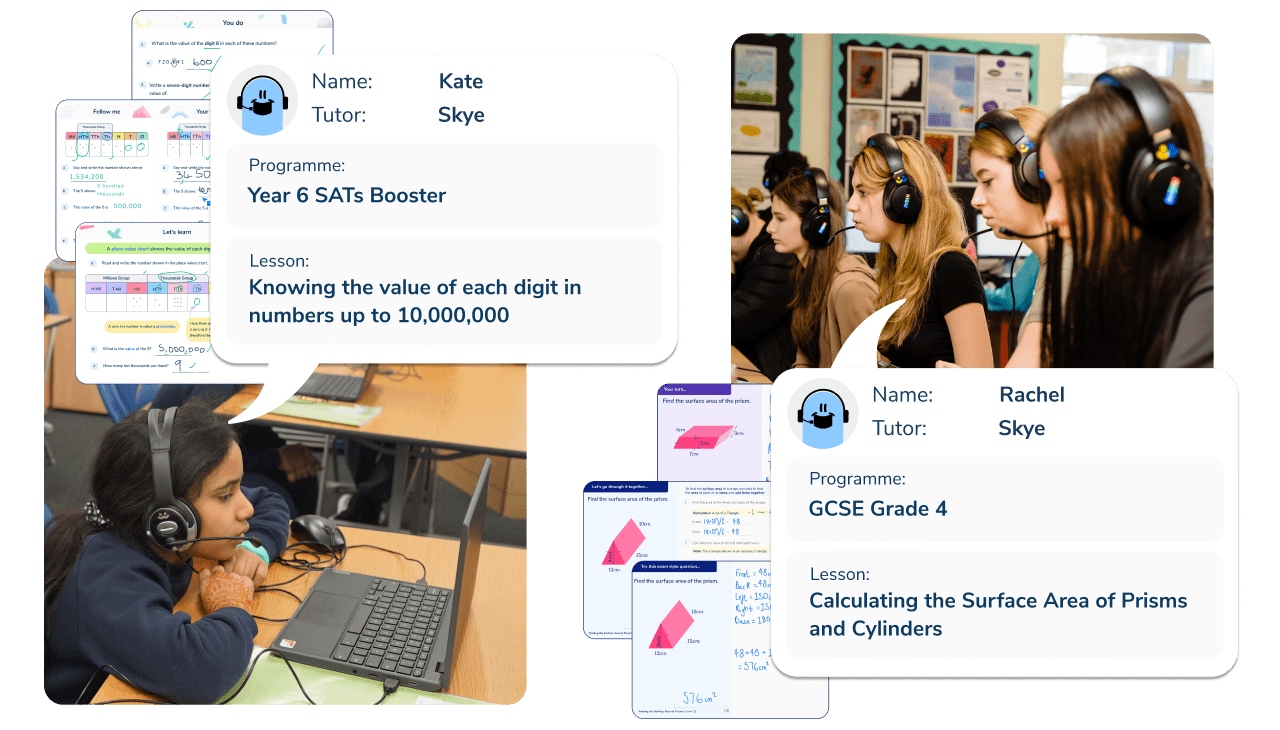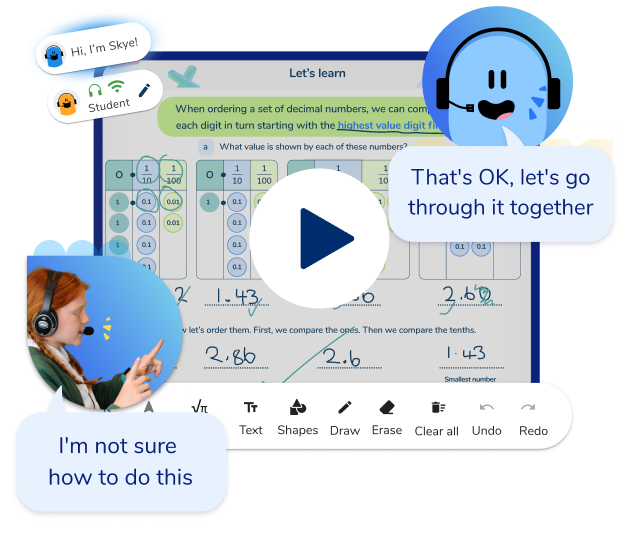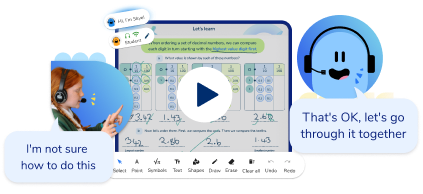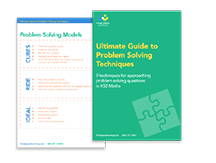Maths Problem Solving At KS2: Strategies and Resources For Primary School Teachers
Maths problem solving KS2 is crucial to succeeding in national assessments. If your Key Stage 2 pupils are still struggling with reasoning and problem solving in Maths, here are some problem solving strategies to try with your classes; all aligned to Ofsted’s suggested primary school teaching strategies.
Reasoning and problem solving are widely understood to be one of the most important activities in school mathematics. As far back as 1982, The Cockcroft Report, stated:
‘The ability to solve problems is at the heart of mathematics. Mathematics is only “useful” to the extent to which it can be applied to a particular situation and it is the ability to apply mathematics to a variety of situations to which we give the name “problem solving”. […] At each stage […] the teacher needs to help pupils to understand how to apply the concepts and skills which are being learned and how to make use of them to solve problems. These problems should relate both to the application of mathematics to everyday situations within the pupils’ experience, and also to situations which are unfamiliar.’
Thirty plus years later and problem solving is still the beating heart of the Maths curriculum and – along with fluency and reasoning – completes the triad of aims in the 2014 New National Curriculum.
Ofsted’s view on problem solving in the Maths curriculum
Despite its centrality, Ofsted report that ‘problem solving is not emphasised enough in the Maths curriculum’. Not surprisingly, problem solving isn’t taught that well either because teachers can lack confidence, or they tend to rely on a smaller range of tried and tested strategies they feel comfortable with but which may not always ‘hit home’. If you’re looking to provide further support to those learners who haven’t yet mastered problem solving, you probably need a range of different strategies, depending on both the problem being attempted and the aptitude of the pupil.
We’ve therefore created a free KS2 resource aimed at Maths Coordinators and KS2 teachers that teaches you when and how to use 9 key problem solving techniques: The Ultimate Guide to Problem Solving Techniques
The context around KS2 problem solving
According to Jane Jones, former HMI and National Lead for Mathematics, in her presentation at the Jurassic Maths Hub:
- Problems do not have to be set in real-life contexts, beware pseudo contexts.
- Providing a range of puzzles and other problems helps pupils to reason strategically to approach problems, sequence unfolding solutions, and use recording to help their mathematical thinking for next steps.
- It is particularly important that teachers and TAs stress reasoning, rather than just checking whether the final answer is correct.
- Pupils of all ability need to learn how to solve problems – not just the high attainers or fastest workers.
The Ultimate Guide to Problem Solving Techniques
9 ready-to-go problem solving techniques with accompanying tasks to get KS2 reasoning independently
Download Free Now!How to approach KS2 maths problems
So what do we do? Well Ofsted advice is pretty clear on what to do when teaching problem solving. Jane Jones says we should:
- Set problems as part of learning in all topics for all pupils.
- Vary the ways in which you pose problems.
- Try to resist prompting pupils too soon and focusing on getting ‘the answer’ – pupils need to build their confidence, skills and resilience in solving problems, so that they can apply them naturally in other situations.
- Make sure you discuss alternative approaches with pupils to help develop their reasoning.
- Ensure that problems for high attainers involve demanding reasoning and problem-solving skills, not just harder numbers.
Perhaps more than most topics in Maths, teaching pupils how to approach problem solving questions effectively requires a systematic approach. Pupils can face any number of multi-step word problems throughout their SATs and they will face them without our help. To truly give pupils the tools they need to approach problem solving in Maths we must ingrain techniques for approaching problems.
With this in mind, below are some methods and techniques for you to consider when teaching problem solving in your KS2 Maths lessons. For greater detail and details on how to teach this methods, download the Ultimate Guide to Problem Solving Techniques

Meet Skye, the voice-based AI tutor making maths success possible for every student.
Built by teachers and maths experts, Skye uses the same pedagogy, curriculum and lesson structure as our traditional tutoring.
But, with more flexibility and a lower cost, schools can scale online maths tutoring to support every student who needs it.
Watch Skye in actionModels for approaching KS2 problem solving
Becoming self-assured and capable as a problem solver is an intricate business that requires a range of skills and experience. Children need something to follow. They can’t just pluck a plan of attack out of thin air which is why models of problem solving are important especially when made memorable. They help establish a pattern within pupils so that, when they see a problem, they feel confident in taking the steps towards solving it.
Find out how we encourage children to approach problem solving independently in our blog: 20 Maths Strategies KS2 That Guarantee Progress for All Pupils.
The most commonly used model is that of George Polya (1973), who proposed 4 stages in problem solving, namely:
- Understand the problem
- Devise a strategy for solving it
- Carry out the strategy
- Check the result
Many models have followed the Polya model and use acronyms to make the stages stick. Which model you use can depend on the age of the children you are teaching and sometimes the types of word problems they are trying to solve. Below are several examples of Polya model acronyms:
CUBES
C – Circle the question words
U – Underline key words
B – Box any key numbers
E – Evaluate (what steps do I take?)
S – Solve and check (does my answer make sense and how can I double check?)
RIDE
R – Read the problem correctly.
I – Identify the relevant information.
D – Determine the operation and unit for expressing the answer.
E – Enter the correct numbers and calculate
IDEAL
I – Identify the problem
D – Define the problem
E – Examine the options
A – Act on a plan
L – Look at the consequences
RICE
R – Read and record the problem
I – Illustrate your thinking with pictures, models, number lines etc
C – Compute, calculate and check
E – Explain your thinking
RUCSAC
R – Read the question and underline the important bits
U – Understand: think about what to do and write the number sentences you will need
C – Choose how you will work it out
S – Solve the problem
A – Answer
C – Check
QUACK
Q – Question – read it carefully
U – Understand – underline or circle key elements
A – Approximate – think about the size of your answer
C – Calculate
K – Know if the answer is sensible or not
TEAR
T – Think about the problem and ponder
E – Explore and get to the root of the problem
A – Act by selecting a strategy
R – Reassess and scrutinise and evaluate the efficiency of the method
The idea behind these problem solving models is the same: to give children a structure and to build an internal monitor so they have a business-like way of working through a problem. You can choose which is most appropriate for the age group and ability of the children you are teaching.
The model you choose is less important than knowing that pupils can draw upon a model to follow, ensuring they approach problems in a systematic and meaningful way. A far simpler model – that we use in the Ultimate Guide to KS2 Problem Solving Techniques – is UCR: Understand the problem, Communicate and Reflect.
You then need to give pupils lots of opportunities to practice this! You can find lots of FREE White Rose Maths aligned maths resources, problem solving activities and printable worksheets for KS1 and KS2 pupils in the Third Space Learning Maths Hub.
You might also be interested in:
- 25 Fun Maths Problems For KS2 And KS3 (From Easy To Very Hard!)
- 30 Problem Solving Maths Questions And Answers For GCSE
- Why SSDD Problems Are Such An Effective Tool To Teach Problem Solving At KS3 & KS4
What’s included in the guide?
After reading the Ultimate Guide to KS2 Problem Solving Techniques, we guarantee you will have a new problem solving technique to test out in class tomorrow. It provides question prompts and activities to try out, and shows you step by step how to teach these 9 techniques
- Open ended problem solving
- Using logical reasoning
Working backwards
Drawing a diagram
Drawing a table
Creating an organised list
Looking for a pattern
Acting it out
Guessing and checking
Cognitive Activation: getting KS2 pupils in the lightbulb zone
If you need more persuasion, pupils who use strategies that inspire them to think more deeply about maths problems are linked with higher Maths achievement. In 2015 The National Education Research Foundation (NFER) published ‘PISA in Practice: Cognitive Activation in Maths’. This shrewd report has largely slipped under the Maths radar but it offers considerable food for thought regarding what we can do as teachers to help mathematical literacy and boost higher mathematical achievement.
Cognitive Activation isn’t anything mysterious; just teaching problem solving strategies that pupils can think about and call upon when confronted by a Maths problem they are trying to solve. Cognitive It encourages us as teachers to develop problems that can be solved in more than one way and ‘may require different solutions in different contexts’. For this to work, exposing children to challenging content and encouraging a culture of exploratory talk is key. As is:
- Giving pupils maths problem solving questions that require them to think for an extended time.
- Asking pupils to use their own procedures for solving complex problems.
- Creating a learning community where pupils are able to make mistakes.
- Asking pupils to explain how they solved a problem and why they choose that method.
- Presenting pupils with problems in different contexts and ask them to apply what they have learned to new contexts.
- Giving pupils problems with no immediately obvious method of solution or multiple solutions.
- Encouraging pupils to reflect on problems.
Sparking cognitive activation is the same as sparking a fire – once it is lit it can burn on its own. It does, however, require time, structure, and the use of several techniques for approaching problem solving. Techniques, such as open-ended problem solving, are usually learned by example so we advise you create several models to go through with pupils, as well as challenge questions for independent work. Many examples exist and we encourage you to explore more (e.g. analysing and investigating, creating a tree diagram, and using simpler numbers).
Read these:
That time, effort, and planning will – however – be well spent. Equipping pupils with the tools to solve problems they have never seen before is more akin to teaching for life than teaching for Maths. The skills they gain from being taught problem solving successfully will be skills they use and hone for the rest of their life – not just for their SATs.
For a range of problem solving techniques, complete with explanations, contextual uses, example problems and challenge questions – don’t forget to download our free Ultimate Guide to KS2 problem solving and reasoning techniques resource here.
KS2 problem Solving FAQs
Here are some techniques to teach problem solving to primary school pupils:
Open ended problem solving
Using logical reasoning
Working backwards
Drawing a diagram
Drawing a table
Creating an organised list
Looking for a pattern
Acting it out
Guessing and checking
Ofsted say that teachers can encourage problem-solving by:
Setting problems as part of learning in all topics for all pupils.
Varying the ways in which you pose problems.
Trying to resist prompting pupils too soon and focusing on getting ‘the answer’ – pupils need to build their confidence, skills and resilience in solving problems, so that they can apply them naturally in other situations.
Making sure you discuss alternative approaches with pupils to help develop their reasoning.
Ensuring that problems for high attainers involve demanding reasoning and problem-solving skills, not just harder numbers.
DO YOU HAVE STUDENTS WHO NEED MORE SUPPORT IN MATHS?
Skye – our AI maths tutor built by teachers – gives students personalised one-to-one lessons that address learning gaps and build confidence.
Since 2013 we’ve taught over 2 million hours of maths lessons to more than 170,000 students to help them become fluent, able mathematicians.
Explore our AI maths tutoring or find out about an online maths tutor for your school.






